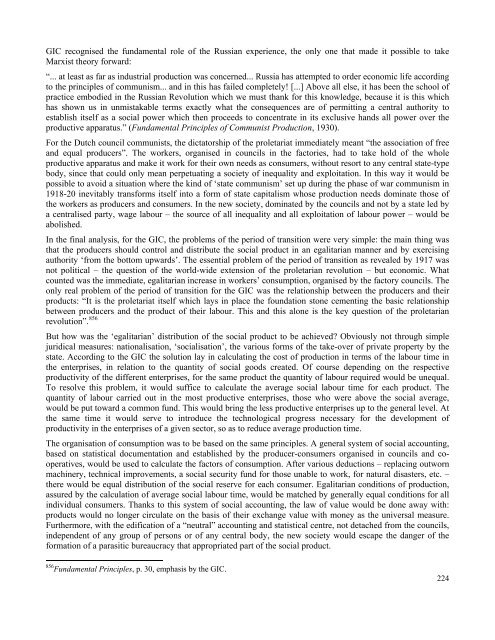The German-Dutch Communist Left - Libcom
The German-Dutch Communist Left - Libcom
The German-Dutch Communist Left - Libcom
You also want an ePaper? Increase the reach of your titles
YUMPU automatically turns print PDFs into web optimized ePapers that Google loves.
GIC recognised the fundamental role of the Russian experience, the only one that made it possible to take<br />
Marxist theory forward:<br />
“... at least as far as industrial production was concerned... Russia has attempted to order economic life according<br />
to the principles of communism... and in this has failed completely! [...] Above all else, it has been the school of<br />
practice embodied in the Russian Revolution which we must thank for this knowledge, because it is this which<br />
has shown us in unmistakable terms exactly what the consequences are of permitting a central authority to<br />
establish itself as a social power which then proceeds to concentrate in its exclusive hands all power over the<br />
productive apparatus.” (Fundamental Principles of <strong>Communist</strong> Production, 1930).<br />
For the <strong>Dutch</strong> council communists, the dictatorship of the proletariat immediately meant “the association of free<br />
and equal producers”. <strong>The</strong> workers, organised in councils in the factories, had to take hold of the whole<br />
productive apparatus and make it work for their own needs as consumers, without resort to any central state-type<br />
body, since that could only mean perpetuating a society of inequality and exploitation. In this way it would be<br />
possible to avoid a situation where the kind of ‘state communism’ set up during the phase of war communism in<br />
1918-20 inevitably transforms itself into a form of state capitalism whose production needs dominate those of<br />
the workers as producers and consumers. In the new society, dominated by the councils and not by a state led by<br />
a centralised party, wage labour – the source of all inequality and all exploitation of labour power – would be<br />
abolished.<br />
In the final analysis, for the GIC, the problems of the period of transition were very simple: the main thing was<br />
that the producers should control and distribute the social product in an egalitarian manner and by exercising<br />
authority ‘from the bottom upwards’. <strong>The</strong> essential problem of the period of transition as revealed by 1917 was<br />
not political – the question of the world-wide extension of the proletarian revolution – but economic. What<br />
counted was the immediate, egalitarian increase in workers’ consumption, organised by the factory councils. <strong>The</strong><br />
only real problem of the period of transition for the GIC was the relationship between the producers and their<br />
products: “It is the proletariat itself which lays in place the foundation stone cementing the basic relationship<br />
between producers and the product of their labour. This and this alone is the key question of the proletarian<br />
revolution”. 856<br />
But how was the ‘egalitarian’ distribution of the social product to be achieved? Obviously not through simple<br />
juridical measures: nationalisation, ‘socialisation’, the various forms of the take-over of private property by the<br />
state. According to the GIC the solution lay in calculating the cost of production in terms of the labour time in<br />
the enterprises, in relation to the quantity of social goods created. Of course depending on the respective<br />
productivity of the different enterprises, for the same product the quantity of labour required would be unequal.<br />
To resolve this problem, it would suffice to calculate the average social labour time for each product. <strong>The</strong><br />
quantity of labour carried out in the most productive enterprises, those who were above the social average,<br />
would be put toward a common fund. This would bring the less productive enterprises up to the general level. At<br />
the same time it would serve to introduce the technological progress necessary for the development of<br />
productivity in the enterprises of a given sector, so as to reduce average production time.<br />
<strong>The</strong> organisation of consumption was to be based on the same principles. A general system of social accounting,<br />
based on statistical documentation and established by the producer-consumers organised in councils and cooperatives,<br />
would be used to calculate the factors of consumption. After various deductions – replacing outworn<br />
machinery, technical improvements, a social security fund for those unable to work, for natural disasters, etc. –<br />
there would be equal distribution of the social reserve for each consumer. Egalitarian conditions of production,<br />
assured by the calculation of average social labour time, would be matched by generally equal conditions for all<br />
individual consumers. Thanks to this system of social accounting, the law of value would be done away with:<br />
products would no longer circulate on the basis of their exchange value with money as the universal measure.<br />
Furthermore, with the edification of a “neutral” accounting and statistical centre, not detached from the councils,<br />
independent of any group of persons or of any central body, the new society would escape the danger of the<br />
formation of a parasitic bureaucracy that appropriated part of the social product.<br />
856 Fundamental Principles, p. 30, emphasis by the GIC.<br />
224
















